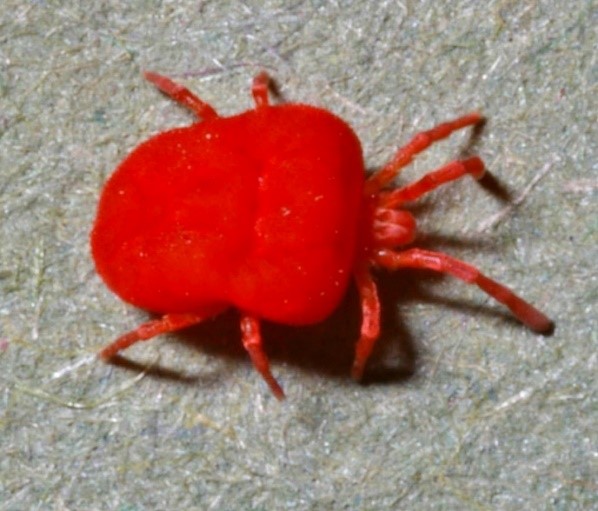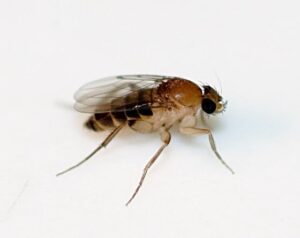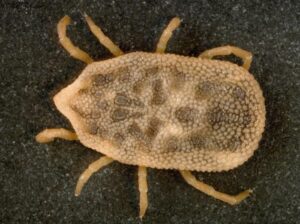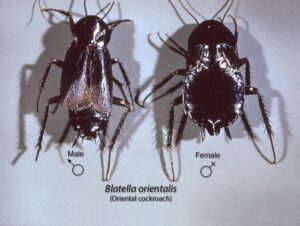Harvest Mites or Chiggers:
General Description
|
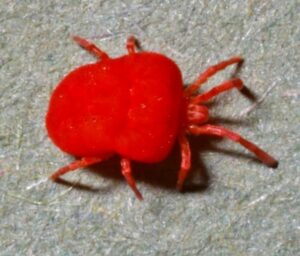 |
Life Cycle and Common Characteristics
- After one week of the egg laying, the egg shell splits, exposing the mature larva.
- Chiggers are the larval-staged organism in the life cycle of the harvest mites.
- It prefers to live in dry areas at a depth of 5-8 cm, so it can be found in home barns in feeding and resting places, where it feeds on decomposing organic matter.
- In most temperate zone, chiggers have one annual generation.
Damage and Medical Implications
- Followed by the genus Trombicula, in which the adult animals and nymphs are non-intrusive, and live in the land free living.
- The larval stage is the stage that parasitizes humans, dogs, and other animals and birds.
- The mite transmits Tsutsugamushi (mite disease) to humans, and the cause is a type of rickettsia.

- Females lay eggs on the soil, and the larva comes out after 6 days and climbs the grass or walls, then sticks to the passing animal or human, and the larva pierces the skin and injects the secretions of the salivary glands that work to analyze the skin tissues, then it feeds on the digested tissues (i.e. it does not feed on the blood of the host). The person does not feel the stages of puncturing the skin and decomposing the tissues, but welts or blister-like appearance appear later on the body (each welt measured approximately 3-4 mm in diameter) and a strong tendency to scratch, so the inflammation increases and ulcers are formed that may be contaminated with bacteria.

- The rickettsia microbe is transmitted from the larvae to the next stages, then to the eggs, and when the larvae emerge, they are infectious with the pathogen.
- Scabies, Itch Mites or Short-Legged Mites:
General Description
|
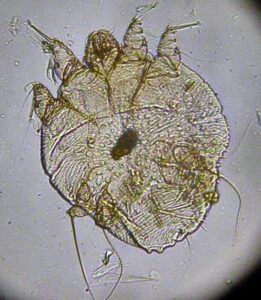
Credit: Kalumet |
Life Cycle and Common Characteristics
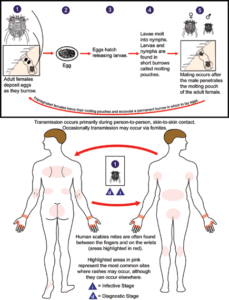
- The most important subfamily is the short-legged mite Sarcoptes scabiei, also called the itch mite.
- This species infests humans, horses, sheep, rabbits, cats, and birds, as well as cattle and camels.
- The female carrying eggs (their length ranges from a few millimeters to about 2.5 cm) digs skin-branching tunnels in thin areas of the skin, especially between the fingers, on the arms, on the hips, and on the genitals. The depth of the tunnel is from several millimeters to several centimeters.
- Only the adult female penetrates the host and paves the way for the remaining instars to enter. The female can bury herself in the skin within 3 minutes. She lays eggs at the end of the tunnel at a rate of 3 eggs per day for two months. Then, the female dies after that. The eggs hatch into larvae after 3-5 days, which may remain inside the tunnel or dig new ones. The larva molts twice within 6-8 days and turns into a full-fledged animal.
- Males (smaller than females) dig their own tunnels and then leave them to roam the surface of the skin in search of females.
- The life cycle takes 10-14 days.
Damage and Medical Implications
- Species of the family Sarcoptidae and Demodiidae cause scabies in humans. Manifestations and symptoms of scabies vary according to the type of mites causing it.
|
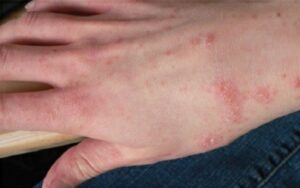
Credit: CDC |
- The general symptoms of scabies are the occurrence of infections and skin tumors accompanied by a severe itching tendency, which causes the infection to widen, the skin cracks, the serum comes out of it, and the hair falls out. If the affected place is rubbed with anything, it will rupture and ugly exfoliation will form. Some abscesses may form if the wounds are contaminated with bacteria.
- Transmission occurs primarily by the transfer of the impregnated females during person-to-person, skin-to-skin contact. Occasionally transmission may occur via bedding or clothing.

